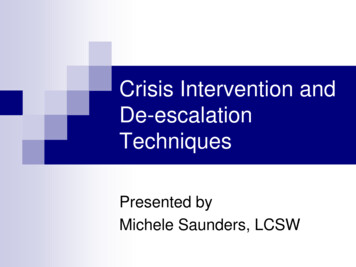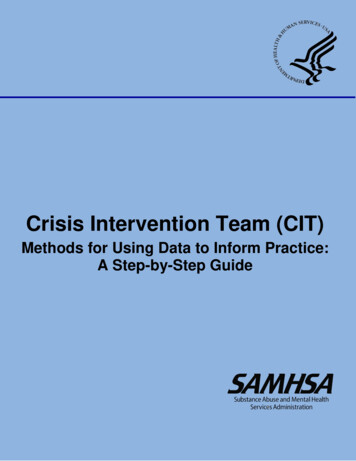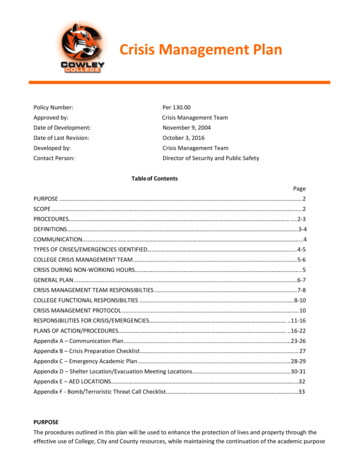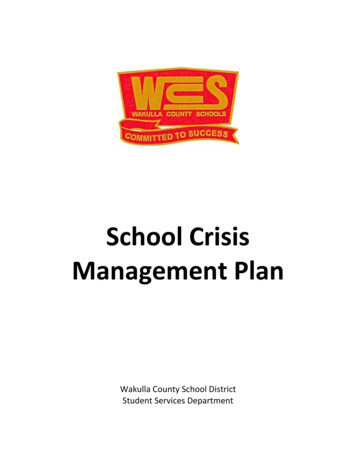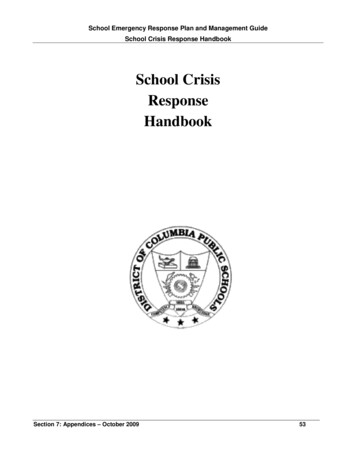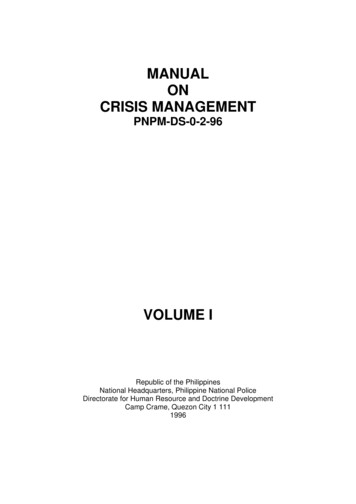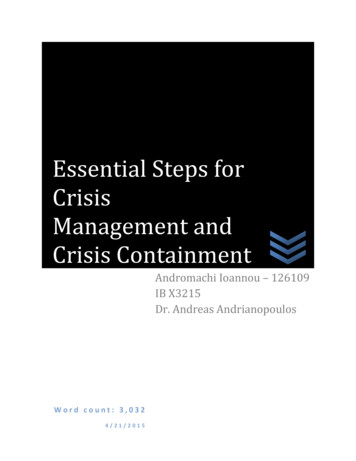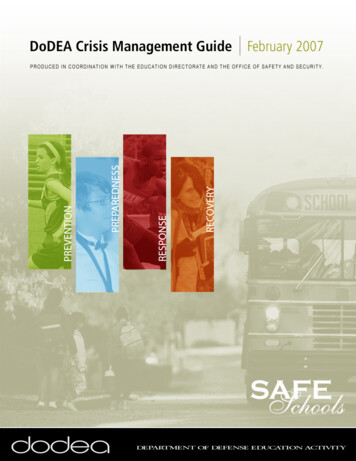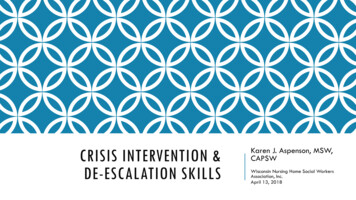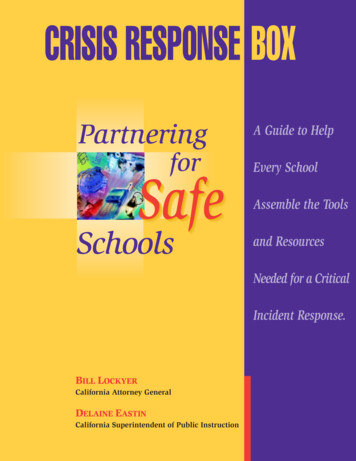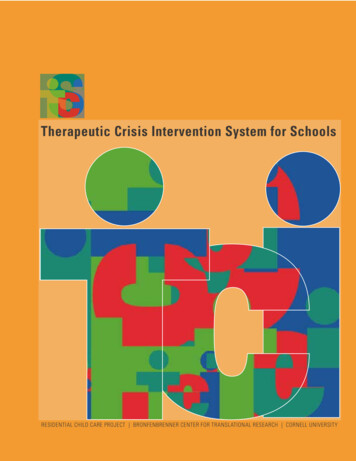
Transcription
Therapeutic Crisis Intervention System for SchoolsRESIDENTIAL CHILD CARE PROJECT BRONFENBRENNER CENTER FOR TRANSLATIONAL RESEARCH CORNELL UNIVERSITY
Therapeutic Crisis Intervention SystemFor SchoolsInformation BulletinResidential Child Care ProjectBronfenbrenner Center for Translational ResearchCollege of Human EcologyCornell University, Ithaca, NY USA Residential Child Care Project, 2021
ContentsModule One: Crisis PreventionPreface3Criteria for an Effective Crisis Prevention and Management System5Questions for Implementation Assessment9Developing School Policies and Procedures on the Use of Physical Restraint14Research Foundations of TCI17TCI Implementation Study19Learning From Tragedy: The Results of a National Study ofFatalities in Out-of-Home Care25Bibliography28TCI Faculty, Instructors, and Staff37Figures and Tables2Figure 1. Research, Practice, and Evaluation Cycle3Figure 2. RCCP Programs4Figure 3. Implementation Criteria: Organizational Cornerstones of the TCIS System5Figure 4: Model Policy for Use of Physical Restraints in Schools17Figure 5. Overview of Evaluation Design and Timeline20Figure 6. Multi-Method Evaluation20Table 1. Overview of the Evaluation Design22Table 2. Results of Implementation and Evaluation Project23THERAPEUTIC CRISIS INTERVENTION SYSTEM FOR SCHOOLS: Residential Child Care Project, Cornell University
PrefaceThe Bronfenbrenner Center for TranslationalResearch (BCTR), formerly the Family LifeDevelopment Center (FLDC), was established byNew York State legislation in 1974. The center’smission is to improve professional and public effortsto understand and deal with risk and protectivefactors in the lives of students, youth, families, andcommunities that affect family strength, studentwellbeing, and youth development. The TherapeuticCrisis Intervention System is one of several programsdelivered by the BCTR relevant to the lives ofstudents, families, and care agencies.In the early 1980s, under a grant from the NationalCenter on Child Abuse and Neglect, CornellUniversity developed the Therapeutic CrisisIntervention (TCI) crisis prevention and interventionmodel for residential child care organizations as partof the Residential Child Care Project (RCCP). Sincethe curriculum’s inception there have been fivemajor revisions. The revision process has generallyincluded (a) examining the evaluation results andresearch conducted by the RCCP, (b) reviewingrelated literature and research, (c) conducting surveysof organizations using the TCI system, (d) talkingto other crisis management training providers, and(e) convening experts for consultation and review.Although TCI was originally developed to providechildren’s residential centers with an effective crisismanagement system, many of the centers hadon-grounds schools for the children in their care.Because of the initial success of TCI in the residentialprograms, residential centers began teaching theiron-grounds school staff the TCI curriculum. Overtime, some of the New York States Boards ofCooperative Educational Services (BOCES) begantraining their staff in TCI to help their staff managecrisis more effectively with the special educationpopulation.During the past 10 years the number of schoolsimplementing TCI as their crisis management systemhas increased dramatically. Additionally, federal andstate school guidelines regulating the use of physicalrestraints are being developed. Although TCI hasbeen successful in helping school staff better managestudents in crisis in schools, the TCI curriculum isgeared towards residential care workers.The decision was made by Cornell University’sRCCP to explore the possibility of adapting TCIPrefacefor schools. During a RCCP TCI retreat held inIthaca, NY, 2007, a group of school experts cametogether to discuss the crisis intervention needsfor schools, how TCI could met those needs, andwhat changes needed to be made to adapt TCI forschools. It was in that spirit that TCI for Schools(TCIS) has been adapted and developed. The TCISsystem assists public and private schools in preventingcrises from occurring, de-escalating potential crises,managing disruptive and acute physical behavior,reducing potential and actual injury to students andstaff, teaching students adaptive coping skills, anddeveloping a learning organization. This model givesorganizations a framework for implementing a crisisprevention and management system that reducesthe need to rely on high-risk interventions andcomplements the Response to Intervention (RTI)approach used in the United States.The RCCP supports vigorous and ongoing in-schoolevaluation of TCIS training and implementationefforts through testing participants’ knowledge andskills, a certification program, formal assessment,and direct monitoring of agencies’ use of high-riskinterventions. The RCCP seeks to maintain aleadership role in discovering new knowledge,establishing new approaches to knowledgedissemination, and developing innovative programs toenable schools to serve students, youth, and familiesmore effectively by building strong linkages amongresearch, outreach activities, and evaluation efforts.These relationships are viewed as cyclical: researchleads to the development of innovative and effectiveoutreach programs, which are carefully evaluated.Evaluation activities contribute directly to theadaptation and improvement of outreach programsand may also contribute to new research. In-houseand external evaluations have been essential inmodifying intervention strategies and protocols toimprove the TCI system’s effectiveness for a widerange of organizations (see Figure 1).ResearchEvaluationOutreachFigure 1. Research, Practice, and Evaluation CycleTHERAPEUTIC CRISIS INTERVENTION SYSTEM FOR SCHOOLS: Residential Child Care Project, Cornell University3
4Professionaldevelopmentprograms forTCI-trainedpractitioners.Not a TxTprogram.A TxT addition tobasic TCI.Topics focus oncurrent issues.*Required tomaintaintrainercertification.TxT Training of TrainersTCIWorkshopsMorecomprehensivethan basic TCI, itincludesassessment,planning, andtraining of trainerson location.On-SiteTrainingTCIUpdates*Basic TCI training,offered atlocationsthroughoutthe U.S. andabroad.RegularlyScheduledTrainingTCI Training of Trainers [TxT]TCI training withoutphysicalinterventiontechniques foradults providingcare for youngpeople in theirhomes. Thisprogram is alsooffered as anUpdate.TCI Training forFamily CareProvidersA Training forTrainers (TxT) withor without physicalrestraint andoffered the same asthe TCI TxT. Thisprogram is alsooffered as anUpdate.TCI Training forSchoolsTHERAPEUTIC CRISIS INTERVENTION [TCI]COMPONENTThe mostcomprehensive TCIpackage offered. Itincludesassessment,training,implementation,and technicalassistancefollow-up for a1-1/2 to 2-yearperiod.TCI AssessmentAndImplementationPackageTraining Essentials ofInstitutionalAbuse Workshops CommunitySeminars Investigations Case Reviews FatalityReviews PreventionStrategiesTechnicalAssistanceIAB provides training and technicalassistance to governmental bodies in theprevention, investigation and remediation ofmaltreatment in out-of-home care.INSTITUTIONAL ABUSE [IAB]COMPONENTRESIDENTIAL CHILD CARE PROJECT PROGRAMSThe CARE component works directly withchild caring organizations to establish asafe, developmentally appropriate, andtrauma sensitive framework for practicethat serves the best interest of the child.CARE (Children and ResidentialExperiences: Creating Conditions forChange)CARECOMPONENTPrefaceFigure 2. RCCP ProgramsTHERAPEUTIC CRISIS INTERVENTION SYSTEM FOR SCHOOLS: Residential Child Care Project, Cornell University
for an Effective Crisis Prevention and Management SystemCriteria for an EffectiveCriteriaCrisisPrevention andManagement SystemIn his book, The Fifth Discipline,The Art and Practiceof the Learning Organization (1990, p. 3), Peter Sengedefines learning organizations as: organizations where people continuallyexpand their capacity to create the resultsthey truly desire, where new and expansivepatterns of thinking are nurtured, wherecollective aspiration is set free, and wherepeople are continually learning to see thewhole together.Organizations can only learn when the people whomake up the organization learn. Leadership mustfoster openness, collaborative decision-making,professional development, and a shared vision ofhow the organization should work. Leadershipneeds to set bold goals and high expectations for staffand students and provide the support and resourcesnecessary to achieve the goals. Implementing TCISwith the goal of reducing the need for high-riskmanagement strategies requires that schools put inplace a system to promote learning and reflectivepractice.For TCIS to be an effective crisis managementsystem, the following five general domains need to beaddressed: (a) leadership and administrative support,(b) social work and clinical services participation,(c) supervision and post crisis response, (d) trainingand competency standards, and (e) data-drivenincident monitoring and feedback (Nunno et al.,2006). (See Figure 2).Leadership and administrative support. The levelof effectiveness to prevent and reduce the needfor high-risk interventions depends on and beginswith leadership’s commitment to TCIS (Bullard,Fulmore, & Johnson, 2003; Carter, Jones, & Stevens,2008; Child Welfare League of America BestPractice Guidelines, 2004; Colton, 2008; Donat,1998, 2005; Farragher, 2002; Hellerstein et al., 2007;Huckshorn, 2006; Miller et al., 2006; Murphy &Bennington-Davis, 2005; National Associationof State Mental Health Program Directors(NASMHPD), 2003; Nunno et al., 2003; Paterson,Leadbetter, Miller, & Chrichton, 2008; Petti et al.,2003; Ryan, Peterson, Tetrault, & Van der Hagen,2007; Stefan & Phil, 2006; Thompson, Huefner,Vollmer, Davis, & Daly, 2008).For schools, the leadership commitment beginswith the district leadership or local educationalagencies who in turn provide the school leadershipwith guidance and support to fully implement thecrisis management system. When leadership is fullyinformed about the TCIS crisis prevention andmanagement system and understands its foundation,it is more likely that leaders will be able to supportthe necessary components that are integral to itsimplementation and maintenance. This means thatschool leadership can clearly communicate the crisisprocedures, policies, and guidelines to everyone inthe organization so that all staff members knowwhat to do when confronted with potential crises.It also means that staff members throughout thebuilding know how to prevent, de-escalate, andcontain a student’s aggressive and acting out behaviorconsistent with school guidelines.A clear school and school district philosophy andframework are essential for establishing a schoolculture that promotes the academic and social growthand development of students with emotional andbehavioral difficulties and for establishing practicesLeadership ing andFeedbackSocial Work andClinical ServicesParticipationSCHOOLSSupervision andPost CrisisResponseTraining andCompetencyStandardsFigure 3. Implementation Criteria: OrganizationalCornerstones of the TCIS SystemTHERAPEUTIC CRISIS INTERVENTION SYSTEM FOR SCHOOLS: Residential Child Care Project, Cornell University5
Criteria for an Effective Crisis Prevention and Management Systemthat are in the best interests of the students (Anglin,2002). Leaders can promote a school culture thatestablishes an environment where students can learnby valuing developmentally appropriate practiceabove control and expediency. With a positive, traumasensitive, and strength based culture and climate,and appropriate teaching and support based on theneeds of individual students, schools can decreasetheir reliance on punitive and coercive interventionsand restraints (Bullard et al., 2003; Colton, 2008;Farragher, 2002; Hellerstein et al., 2007; Huckshorn,2006; McAfee, 2006; Miller et al., 2006; Murphy &Bennington-Davis, 2005; NASMHPD, 2003; Patersonet al., 2008; Petti et al., 2003; Stefan & Phil, 2006).By providing sufficient resources including adequateand qualified staff, support for regular external andinternal monitoring, and clear rules and proceduresthat have safeguards against abusive practices,leadership promotes positive programming and anorganizational culture to sustain a safe and caringcommunity within the school and reduce the needfor use of restraints in school (McAfee, 2006; Ryan etal., 2007).Social work and clinical services participation. Socialwork and clinical services play an important rolein overseeing and monitoring staff ’s responses tostudents in crisis. Developing and implementingan individual crisis management plan (ICMP) orsome form of emergency restraint plan is critical toresponding appropriately and in the best interest ofa student in crisis (Bullard et al., 2003; Carter et al.,2008; CWLA Best Practice Guidelines, 2004; Donat,1998, 2005; Farragher, 2002; Hellerstein et al., 2007;Huckshorn, 2006; Murphy & Bennington-Davis,2005; NASMHPD, 2003; Nunno et al., 2003;Paterson et al., 2008; Salias & Wahlbeck, 2005; Stefan& Phil, 2006).The United States Federal Law, Individuals withDevelopmental Education Improvement Act (IDEA),governs how states provide early intervention andeducational services to children with disabilities.IDEA stresses the importance of IndividualEducation Plan (IEP) teams developing behavioraland educational plans to minimize the need forphysical restraints. An individual crisis managementplan (ICMP) or emergency safety plan should be6developed and in place for any student who is likelyto be restrained.The ICMPs are more effective when developed withinput from classroom team members, the student,and the student’s family, and are written in clearand concise language so that the classroom staff canimplement the plan. All students with IEPs shouldhave a risk assessment of the student’s propensityto engage in high-risk behaviors. The conditionsthat have provoked these behaviors in the past canprovide valuable information. Key questions toaddress are: (a) How can high-risk behaviors beprevented? (b) Is there a need for an ICMP? (c) Whatintervention strategies should be used if an ICMP isnecessary?Well developed ICMPs include strategies forpreventing, de-escalating, and managing potentialhigh-risk behavior specific to the student. Includedin the plan are specific physical interventions, ifappropriate, or alternative strategies if physicalintervention is not an option. It is important toscreen all students in schools for any pre-existingmedical conditions that would be exacerbated if thestudent were involved in a physical restraint. Anymedications that the student may be taking whichwould affect the respiratory or cardiovascular systemshould also be noted. If there is a history of physicalor sexual abuse that could contribute to the studentexperiencing emotional trauma during a physicalrestraint, it is equally important to consider this butcare should be taken for confidentiality reasons notto write this in the plan. Confidentiality can bemaintained by focusing on strategies to help the childin crisis that have the least risk for re-traumatizingthat child. Ongoing reviews of the student’s ICMPwith revisions as the student’s condition changes willhelp staff develop more effective ways to prevent andintervene with the student’s high-risk behaviors. Thisprocess should be data-driven. These decisions shouldbe informed by the data generated from incidentreports.Supervision and post crisis response. Frequent andongoing supportive staff supervision, mentoring, andcoaching are essential for creating and sustaining aschool’s ability to reduce the need for restraint andto serve the best interests of the student (BullardTHERAPEUTIC CRISIS INTERVENTION SYSTEM FOR SCHOOLS: Residential Child Care Project, Cornell University
Criteria for an Effective Crisis Prevention and Management Systemet al., 2003; Colton, 2008; CWLA Best PracticeGuidelines, 2004; Donat, 1998, 2005; Farragher,2002; Huckshorn, 2006; Miller et al., 2006; Murphy& Bennington-Davis, 2005; NASMHPD, 2003;Nunno et al., 2003; Petti et al., 2003; Ryan, Peterson,Tetreault & van der Hagen, 2008; Thompson etal., 2008). Reflective and supportive supervisionis built into the implementation and ongoingmonitoring of the TCIS crisis management system.Building administrators who are fully trained in allof the prevention, de-escalation, and interventiontechniques can provide effective supervision,coaching, and monitoring of their staff members.Fully trained and effective building administratorsshould have reasonable expectations with realistictime frames and schedules for staff so that staffmembers can accomplish tasks and respond tostudents’ needs in a thoughtful and well-plannedmanner.A post crisis response system ensures that all studentsand staff members receive immediate support anddebriefing following a crisis as well as a brief medicalassessment (Bullard et al., 2003; CWLA Best PracticeGuidelines, 2004; Farragher, 2002; Huckshorn, 2006;Miller et al., 2006; Murphy & Bennington-Davis,2005; NASMHPD, 2003; Nunno et al., 2003; Pettiet al., 2003, Ryan et al., 2009). Once things are backto normal, all staff members involved in the restraintcan deconstruct the incident to develop strategies forintervening in the future. It is important to notifyfamilies when their child has been involved in aphysical intervention (Ryan et al., 2009). Buildinga discussion of student crisis incidents into teammeetings helps staff learn from these situations andprovides accountability and support at the highestlevel.Training and competency standards. Trainingand professional development are cornerstones ofany professional organization. Schools that keepstaff informed and updated on the special needsof the students in their classrooms can enhanceacademic success and improve student outcomes.A comprehensive training agenda includesprevention, de-escalation, and management ofcrises as well as child and adolescent development,trauma sensitive interventions, and individual andclassroom behavior support strategies (Bullard et al.,2003; CWLA Best Practice Guidelines, 2004; Donat,2005; Farragher, 2002; M. J. Holden & Curry, 2008;Huckshorn, 2006; Murphy & Bennington-Davis,2005; NASMHPD, 2003; Nunno et al., 2003;Paterson et al., 2008; Petti et al., 2003; Ryan et al.,2008; Thompson et al., 2008).TCIS training is only one part of a comprehensivestaff development program that provides core trainingand specialized training based on the populationserved. TCIS training is only to be conducted by acertified TCIS trainer. The TCIS training should be4-5 days in length with a minimum of 28 classroomhours if physical restraint is taught, 3.5 days with aminimum of 24 hours if protective interventions aretaught, and 3 days with a minimum 21 hours withoutphysical interventions. TCIS trainers are required toattend a Cornell University sponsored TCIS Updateand pass testing requirements at least every 2 years inorder to maintain their certification.Training for staff to refresh TCIS skills is requiredsemi-annually at a minimum. Refreshers are designedto give staff the opportunity to practice de-escalationskills, Life Space Interviewing, emotional first aid,crisis co-regulation, and physical restraint skills, iftrained. At the completion of the initial trainingand each refresher, staff are expected to performthe skills at an acceptable standard of performance.Documentation of these training events andstaff ’s level of competency is critical in order tomaintain the TCIS system and ensure that staff cancompetently use the skills and interventions.Data-driven incident monitoring and feedback.Documentation, data analysis, and feedback to alllevels of staff teams are an important part of restraintreduction efforts (Bullard et al., 2003; Carter et al.,2008; CWLA Best Practice Guidelines, 2004; Donat,2005; Farragher, 2002; H.R. 4247, 2010; Huckshorn,2006; Miller et al., 2006; Murphy & BenningtonDavis, 2005; NASMHPD, 2003; Nunno et al.,2003; Petti et al., 2003; Ryan & Peterson, 2004;Stefan & Phil, 2006; Thompson et al., 2008). Datamanagement includes the documentation of staffsupervision and training and the documentationand monitoring of incidents throughout the school.A school-wide restraint committee appointed byTHERAPEUTIC CRISIS INTERVENTION SYSTEM FOR SCHOOLS: Residential Child Care Project, Cornell University7
Criteria for an Effective Crisis Prevention and Management Systemleadership with the authority and responsibility toenforce documentation requirements and track thefrequency, location, and type of incidents as well asany injuries or medical complaints that occur in theschool helps to monitor the effectiveness of the TCISsystem. This documentation and monitoring systemallows the school to review incidents and makedecisions about individual and organizational practiceand recommend corrective actions.In addition to a school-wide restraint reviewcommittee, a clinical review of incidents, and a teamreview can assist schools in making changes to helpreduce high-risk situations. These reviews focuson different aspects of the incident and providefeedback on any information or suggestions to ateam, clinical services, or administration. Some typeof benchmarking or red flagging should call attentionto any situation that exceeds the norm and requires aspecial review. For example, a red flag might appearwhen the number of incidents per month exceeds aset number, when restraints exceed a certain lengthof time, or when specific complaints or injuries thatare unlikely to occur during a restraint are reported.Schools have been able to reduce physical restraintepisodes and aggressive behavior by following theseguidelines and effectively implementing the TCISsystem. Implementation of TCIS has resulted in anincreased ability on the part of staff to manage andprevent crises. Implementation studies have alsoshown an increased knowledge and skill on the partof all staff to handle crisis episodes effectively, and achange in staff attitude regarding the use of physicalrestraint when TCIS is implemented as designed(Nunno et al., 2003).8THERAPEUTIC CRISIS INTERVENTION SYSTEM FOR SCHOOLS: Residential Child Care Project, Cornell University
Criteria for an Effective Crisis Prevention and Management SystemQuestions For Implementation AssessmentLeadership and Administrative SupportSystem consistent with district and State regulations Is TCIS approved by the school district or local educational authorities? Does the school have a well thought out crisis response plan based on the population? Does the school have ongoing in-services based on the population served?Administration Does the leadership of the school district/building understand and support TCIS as the crisis preventionand management system? Are there adequate resources at the school to support the TCIS system, i.e., training hours, adequatestaffing in classrooms, monitoring and coaching of classrooms, post crisis response, Individual CrisisManagement Plans (ICMPs), and first responders/crisis staff?Policies, rules, and procedures Do the policies and procedures clearly describe intervention strategies taught in the TCIS training? Are the procedures understandable and communicated to all staff? Are there clear guidelines against abusive practice? Is there an informed consent process in place for family or caretakers?External and internal monitoring Are there supports for an ongoing monitoring system? Are external monitoring organizations engaged to review the school’s practice? Do students, parents, and advocates play a role in informing school practice and policy?Culture Does the organizational culture value developmentally appropriate practice above control andexpediency? Do teachers and staff feel supported in using the techniques they learn in TCIS training?Program appropriate to student’s needs Is TCIS an appropriate and effective crisis management system based on the type of students served?THERAPEUTIC CRISIS INTERVENTION SYSTEM FOR SCHOOLS: Residential Child Care Project, Cornell University9
Criteria for an Effective Crisis Prevention and Management SystemSocial Work and Clinical Services ParticipationIndividual Crisis Management Plans (ICMP) Is there an ICMP identifying the students high risk behavior, medical, physical and emotional conditionwith individualized strategies to prevent and de-escalate potential crises? Has a functional analysis of each student’s individual high-risk behavior been completed? Are there specific intervention strategies tailored to the needs of the student? Is the student involved in identifying de-escalation preferences and triggers? If physical restraint may be necessary based on high risk behaviors of the student, are specific restraintsindicated and prescribed? If physical restraint is inappropriate based on the special needs or situation of the student, are therealternative interventions described?Medical Screening Has each student been medically screened for pre-existing conditions that might contraindicate physicalrestraint? Is there documentation about any medication prescribed or combinations of medication taken and theeffects on the student?Documented Ongoing Reviews 10Is the ICMP reviewed on a regular and frequent basis for progress or modification of interventionstrategies?THERAPEUTIC CRISIS INTERVENTION SYSTEM FOR SCHOOLS: Residential Child Care Project, Cornell University
Criteria for an Effective Crisis Prevention and Management SystemSupervision and Post Crisis ResponseAdministrators Fully Trained in TCIS Have the building administrators been trained in TCIS so they can coach, support, and have reasonableexpectations of teachers and staff members?Types of Supervision Do administrators provide on-the-job training in the form of coaching staff in early intervention and LSIskills? Is supervision supportive, frequent, and ongoing?Post-Crisis Multilevel Response Do administrators provide on-the-spot debriefing and support in a crisis situation? Do staff members conduct LSIs with the students after a crisis? Do staff members have time and support to immediately document critical incidents? Do administrators conduct a process debriefing with staff members within 24 hours of the incident? Are critical incidents discussed in meetings in order to share information and develop better interventionstrategies and improve programming?THERAPEUTIC CRISIS INTERVENTION SYSTEM FOR SCHOOLS: Residential Child Care Project, Cornell University11
Criteria for an Effective Crisis Prevention and Management SystemTraining and Competency StandardsBasic / Core Training Do teachers and staff members receive training in skills necessary to competently manage and teach childrenwith special needs, i.e., child development, transition planning, group processing, communication skills,relationship building, trauma assessment, and re-traumatization in addition to quality instruction training?Crisis Intervention Training Do all teachers and staff members receive a minimum of 20 hours of TCIS training (28 hours if physicalrestraint training is included)? Is the training delivered by certified trainers?Ongoing Staff Development Do teachers and staff members attend additional, ongoing training that is relevant to the students andprogram, such as developing appropriate lessons and instruction and effective instructional strategies?Refreshers Do teachers and staff members attend TCIS refreshers at annually (preferably every 3-6 months), 6 hourswithout physical restraint and 12 hours with physical restraint? Do staff members practice and receive corrective feedback on the main skills, i.e., LSI, behavior supportskills, co-regulation strategies during these refreshers (physical interventions if taught)?Credentialling Based on Achieving a Level of Competence12 Are teachers and staff members tested by a certified trainer in the core skill areas? Is the level of competency of each person documented and maintained in that individual’s personnel file? Are teachers and staff members required to demonstrate competency in crisis management skills?THERAPEUTIC CRISIS INTERVENTION SYSTEM FOR SCHOOLS: Residential Child Care Project, Cornell University
Criteria for an Effective Crisis Prevention and Management SystemData-Driven Incident Monitoring and FeedbackCritical Incident Review Committee Is there a school-wide committee that reviews incidents? Does that committee have some authority torecommend and implement policy and changes? Are advocates and/or students involved in review ofincidents?Clinical Review Is there a clinical review of incidents and interventions?Data Monitoring Are incidents documented in a timely and comprehensive manner? Is the following information collected: frequency, location/time, circumstances surrounding the event,student/staff frequency of events, student/staff injuries?Feedback Loop Is the information collected and reviewed by committees fed back into the system to inform the program?Red Flags / Benchmarks Are there benchmarks that, when surpassed, call for review of different strategies?THERAPEUTIC CRISIS INTERVENTION SYSTEM FOR SCHOOLS: Residential Child Care Project, Cornell University13
School Policies on the Use of Physical RestraintDevelopingSchool Policies and Procedures on the Useof Physical RestraintThe use of physical restraint is a complex issue and hasbeen part of the human services field of practice forcenturies. Restraints pose a number of risks to childrenincluding trauma, injury, humiliation, suffering, anddeath. Due to the inherent risk involved in the use ofrestraints, there are state and federal regulations andguidelines that govern the use of restraints in humanservice organizations. The following material includessuggestions for drafting school policies and procedureson the use of physical restraint. Additional tips an
THERAPEUTIC CRISIS INTERVENTION SYSTEM FOR SCHOOLS: Residential Child Care Project, Cornell University 5 Criteria for an Effective Crisis Prevention and Criteria for an Effective Crisis Prevention and Management System Management System In his book, The Fifth Discipline, The Art and Practi
